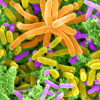News Archive
After the First Decade of Metagenomics, Adolescent Growth Spurt Anticipated
WALNUT CREEK, CA—Mostly hidden from the scrutiny of the naked eye, microbes have been said to run the world. The challenge is how best to characterize them given that less than one percent of the estimated hundreds of millions of microbial species can be cultured in the laboratory. The answer is metagenomics—an increasingly popular approach for extracting the genomes of uncultured microorganisms and discerning their specific metabolic capabilities directly from environmental samples. Now, some ten years after the term was coined, metagenomics is going mainstream and already paying provocative dividends according to a “Q&A,” News and Views by the U.S. Department of Energy Joint Genome Institute (DOE JGI) microbial ecology program head Philip Hugenholtz and MIT researcher Gene Tyson, published in the September 25, 2008 edition of the journal Nature. Read More »
ESnet4 Rolls Out New Cross-Country 10 Gbps Network
The first national ring of ESnet4 went live over the summer, marking a key accomplishment for a long-term plan to build the next-generation science network for researchers working in DOE's national labs, universities and industry. The network ring, the first of several to be built, runs across the country with northern and southern routes before meeting up at various locations along the east and west coast. ESnet4 will enable researchers to send and obtain raw data and research results at a significantly faster rate and with greater reliability. The infrastructure underlying ESnet4 is a joint project between ESnet and Internet2. Read More »
IMPACTS: On the Threshold of Abrupt Climate Changes
Abrupt climate change is a potential menace that hasn’t received much attention. That’s about to change. Through its Climate Change Prediction Program, the U.S. Department of Energy’s Office of Biological and Environmental Research (OBER) recently launched IMPACTS – Investigation of the Magnitudes and Probabilities of Abrupt Climate Transitions – a program led by William Collins of Berkeley Lab’s Earth Sciences Division (ESD) that brings together six national laboratories to attack the problem of abrupt climate change, or ACC. Read More »
Visualizing the unseen forces of turbulence
Its invisible eddies and vortexes can dramatically alter the flight of everything from golf balls to hypersonic jets. Grasping the vast power of turbulence could help researchers design better weather forecasts, more efficient cars, quieter helicopters and even faster ships that “float” through the high seas on a cushion of air. Read More »
NERSC Releases Software Test for Its Next Supercomputer
BERKELEY, Calif.—The Department of Energy’s National Energy Research Scientific Computing Center (NERSC) is looking for a new supercomputer, but is not willing to spend millions of dollars on just any machine. The computer scientists and engineers want to know that their new supercomputer can reliably handle a diverse scientific workload, so they’ve developed the Sustained System Performance (SSP) Benchmarks, a comprehensive test for any system they consider. Read More »
NOAA Awarded 2.6 Million Processor Hours at NERSC to Run Climate Change Models
WASHINGTON, DC – The U.S. Department of Energy’s (DOE) Office of Science will make available more than 10 million hours of computing time for the U.S. Commerce Department’s National Oceanic and Atmospheric Administration (NOAA) to explore advanced climate change models at three of DOE’s national laboratories as part of a three-year memorandum of understanding on collaborative climate research signed today by the two agencies. Read More »
ESnet4 Helps Researchers Seeking the Origins of Matter
Approaching the speed of light, millions of protons will collide per second when the Large Hadron Collider (LHC) comes online this fall. The experiment will generate more data than the international scientific community has ever tried to manage. Scientists suspect the outcome of these “subatomic smashups” will provide valuable insights into the origins of matter and dark energy in the Universe. Read More »
DOE JGI Extends the Capabilities of the Integrated Microbial Genome (IMG) System, Updates the IMG/M Metagenome System, Launches Education Site
WALNUT CREEK, CA—The U.S. Department of Energy Joint Genome Institute (DOE JGI) has extended the capabilities of the Integrated Microbial Genomes (IMG) data management system, updated the content of the IMG/M metagenome data management and analysis system, and has launched its educational companion site, IMG/EDU. Read More »
Biochemical Pathways Identified in Microbial Community
Today’s powerful sequencing machines can rapidly read the genomes of entire communities of microbes, but the challenge is to extract meaningful information from the jumbled reams of data. In a paper posted online in Nature Biotechnology, researchers from the University of Washington, the U.S. Department of Energy Joint Genome Institute (DOE JGI), Lawrence Berkeley National Laboratory, and several other institutions describe a novel approach for extracting single genomes and discerning specific microbial capabilities from mixed community (“metagenomic”) sequence data.[1] Read More »
ESnet Names Steve Cotter to Head Network Serving Scientists around the Globe
Steve Cotter, who has 10 years of experience in designing and deploying research and commercial networks at the national and international scale, has been named as the new head of ESnet, the Department of Energy’s high-speed network supporting science around the world. Read More »







 Instagram
Instagram YouTube
YouTube



